Slab Impulse Response - Voids Under Slab
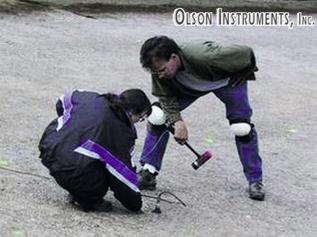
Slab Impulse Response (Slab IR) investigations are performed primarily to identify sub-grade voids below slabs on grade. The method is excellent for evaluating the repair of slab sub-grade support conditions by comparing the support conditions before and after repair
The Slab IR test method can also be used on concrete structures to quickly locate areas of de-lamination or void in the concrete, if the damage is relatively shallow. Slab IR can be performed on reinforced and non-reinforced concrete slabs as well as asphalt or asphalt overlay slabs.
The elements that can be tested include, concrete slabs, pavements, runways, spillways, pond and pool bottoms, and tunnel liners. The Slab IR method is often used in conjunction with GPR for sub-grade void detection and mapping. Testing can locate:
- Erosion beneath concrete slabs in highways, spillways and floors
- Curling of plates
- Anchoring of panels
- De-laminations and honeycombing in bridge decks, slabs, walls and large structures such as dams, chimney stacks and silos
- Freeze-thaw damage
- Presence of Alkali–silica reaction
- De-bonding of asphalt, concrete overlays and patches from concrete substrates
- Quality of stress transfer through load transfer systems across joints in concrete structures
Access
The Slab IR method requires access to the top surface for receiver locations and hammer hitting. The receiver is mounted to the surface of the slab adjacent to the impact location and generally 3-4 inches away. In easy access areas, 400-600 Slab IR tests can be performed in an 8 hour work day.
Principle
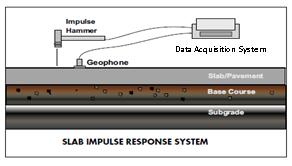
Slab IR uses a low-strain impact with an instrumented, rubber tipped hammer to send stress waves through the tested element. The element acts in a bending mode and a velocity transducer, placed adjacent to the impact point, receives this response. Both the hammer and the geophone are linked to a data acquisition for processing and storage.
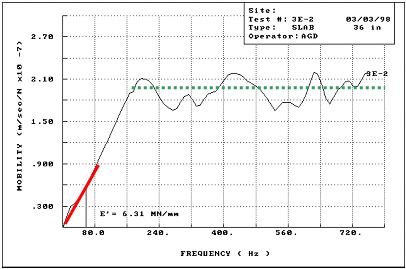 Both the time trace of the hammer force and the velocity transducer are processed into frequency using the Fast Fourier Transform (FFT) algorithm. Dividing the resultant velocity spectrum by the force spectrum then derives the "mobility". An example of such a mobility plot is given below for a solid concrete member.
Both the time trace of the hammer force and the velocity transducer are processed into frequency using the Fast Fourier Transform (FFT) algorithm. Dividing the resultant velocity spectrum by the force spectrum then derives the "mobility". An example of such a mobility plot is given below for a solid concrete member.
The parameters used for the integrity evaluation are:
- The dynamic stiffness (the inverse of the slope below 80 Hz of the mobility plot, the red line)
- The average mobility and the mobility slope (the dotted green line)
- Voids ratio (the ratio between the initial mobility peak to the average mobility)
Effectiveness
The Slab IR method is used to determine the support conditions of the slab and to map out the aerial extent of any void or poor support condition zones, but the method cannot determine the thickness of any voids found. Collecting Slab IR data at multiple, densely-spaced locations can improve the conclusions by mapping relative areas of higher and lower mobility. However, relatively low mobility does not indicate the absence of a sub-grade void, but qualitatively indicates that such an area appears to be more solidly supported than an area with relatively high mobility. For thick slabs (thickness > 600mm), the interpretation of the Slab IR data becomes difficult because the stiffness of the system is controlled by the slab itself and not by the support conditions under the slab.
Interpretation of Data
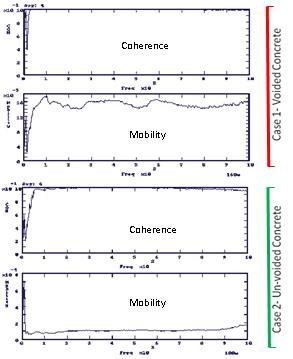 Support condition evaluation includes two measurement parameters.
Support condition evaluation includes two measurement parameters.
- The dynamic stiffness is calculated. The initial slope of the mobility plot indicates the quasi-static flexibility of the system. The steeper the slope of the initial part of the mobility plot, the more flexible and less stiff the system is.
- The shape and/or magnitude of the mobility plot above the initial straight line portion of the curve are an indication of support condition. The response curve is more irregular and has a greater mobility value where concrete support is voided. Good support conditions where the mobility is lower, due to the decreased damping of the slab vibration response. The presence of high amplitude, low frequency spikes in the mobility plot is an additional indication of void conditions.
Platforms Available
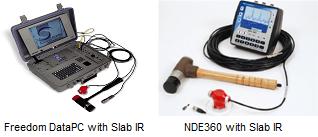 We offer two devices available for the SASW technique. These include the Olson Instruments' NDE 360 and Freedom Data PC. These offer differing levels of mobility and on-site analysis. Please see the individual brochures for more in depth specifications for the platforms.
We offer two devices available for the SASW technique. These include the Olson Instruments' NDE 360 and Freedom Data PC. These offer differing levels of mobility and on-site analysis. Please see the individual brochures for more in depth specifications for the platforms.


